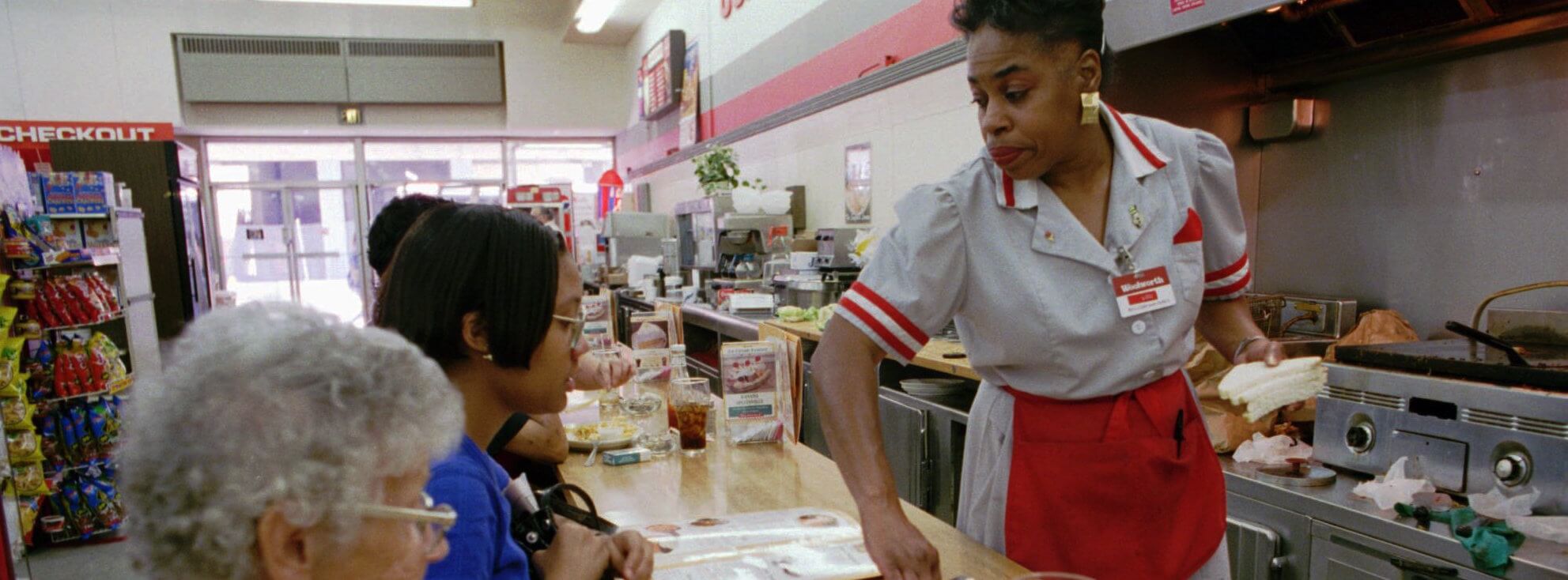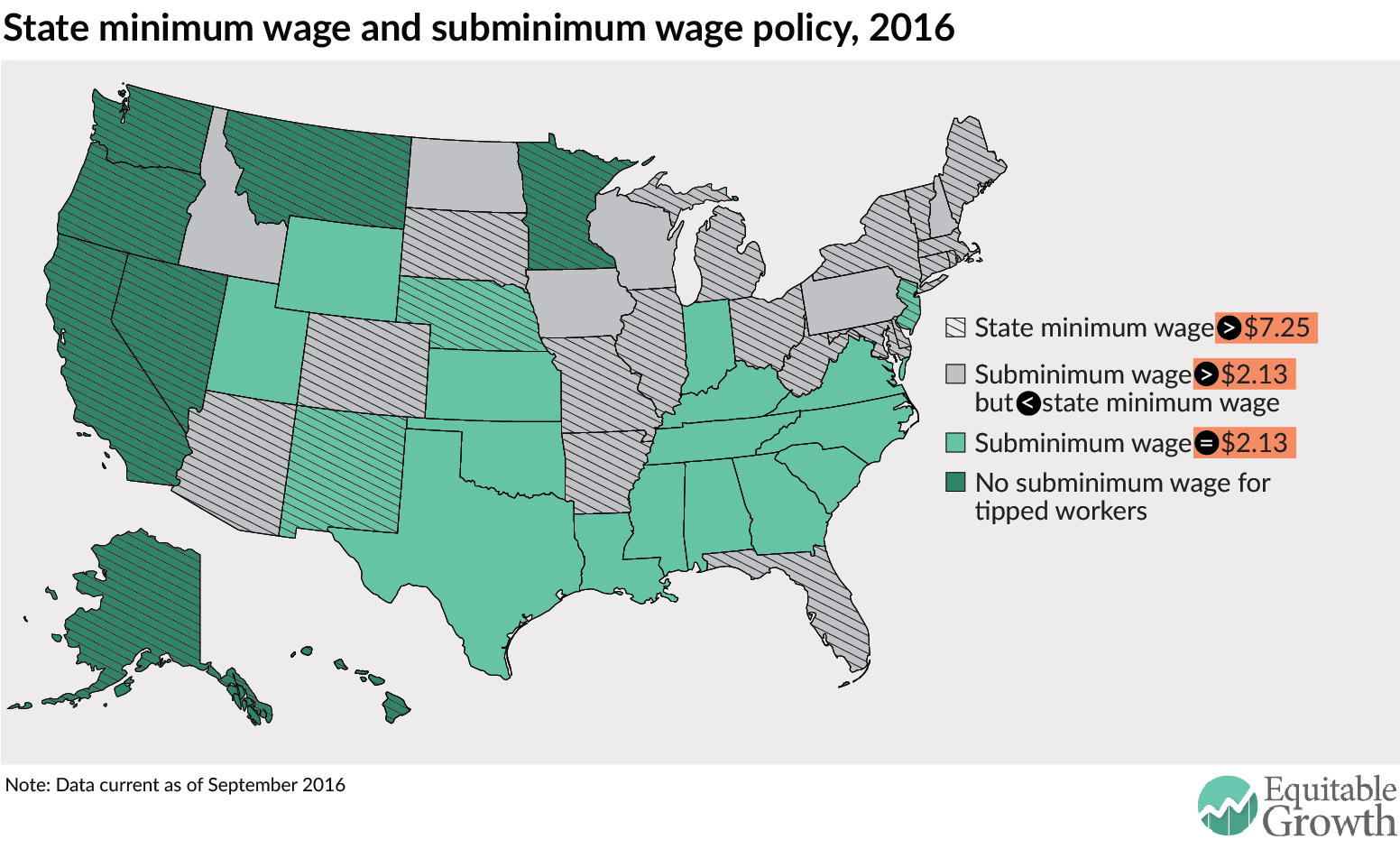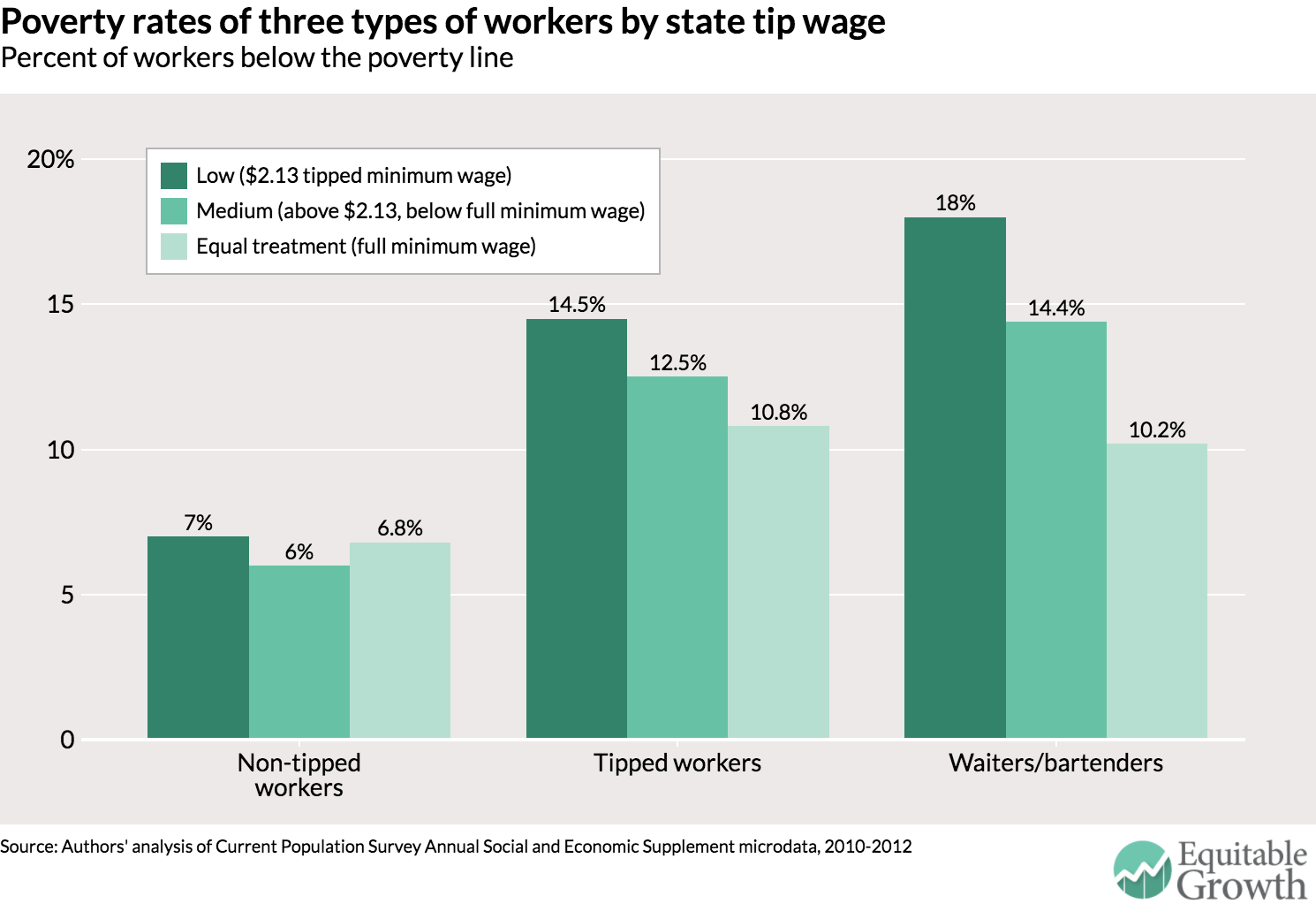Two and a half decades: Still waiting for change

About the author: Sylvia A. Allegretto, Ph.D. is an economist and Co-chair of the Center on Wage and Employment Dynamics at the Institute for Research on Labor and Employment, University of California-Berkeley.
Over the past few years, minimum wage policy has been propelled to the forefront of the economic debate boosted by “Occupy Wall Street,” the “Fight for $15,” and other pro-worker campaigns. One result has been the adoption of numerous minimum wage policies at state and local levels that increased wages for many of our lowest-paid workers. Much action on the minimum wage front is owed to the discussion on inequality as it relates to decades of stagnating or falling wages at the bottom end of the pay scale coupled with the long erosion of the federal minimum wage. Often overlooked in wage policy is the recognition that the federal subminimum wage received by tipped workers has been frozen at $2.13 since 1991.1 There is often confusion and misinformation around the sub-wage floor, the workers who earn it, and the two-tiered system that makes it possible. Future debate and policy consideration on wage floors must include the often forgotten subminimum wage workforce.
Next article: Income volatility, Bradley Hardy
This essay shows that tipped workers are overwhelming female who typically earn low wages. They also have few workplace benefits, live disproportionately in poverty, and experience high rates of sexual harassment—especially in states that set their sub-wage floor at $2.13. These workers also face workplace challenges unique to tipped workers such as unreliable shifts that result in extreme fluctuations in pay. Importantly, the full-service restaurant industry that employs most of the tipped workforce is rapidly growing and is becoming a larger share of the overall workforce—this is the case even in the states that do not allow for a subminimum wage.2
A bit of history will lend some perspective. In 1938 the Fair Labor Standards Act, a New Deal initiative, was signed into law. The new law banned oppressive child labor, set the maximum workweek at 44 hours, and established the first minimum wage at 25¢ an hour. But the law applied to few industries whose combined employment represented about one-fifth of the labor force. The 1966 amendment extended protections to hotel, restaurant, and other service workers who had previously been excluded. At the same time it punctured a permanent hole in the law’s umbrella via the introduction of a “subminimum wage” to be paid to workers who “customarily and regularly receive tips” —otherwise, most of the newly covered workforce.3
The two-tiered system is dependent upon the tip-credit provision—in other words, the amount of the wage bill an employer can pass on to customers in the form of tips. Thus tips are, at least in part, a wage subsidy provided by customers to employers and the subsidy has grown considerably over time. Both wage floors, after adjusting for inflation, are trending downward over time—the difference between them is the allowable federal tip credit. Customers now pay the lion’s share (71 percent) of a tipped worker’s wage bill—while employers pay a base wage that is just 29 percent of the regular minimum wage. (See Figure 1.)
Figure 1

There is a sort of quasi-natural experiment being conducted across the country as there are three general state policy scenarios regarding tipped wages. Additionally, each state’s regular minimum wage is set at the federal policy of $7.25 or above.4 There are 18 states that follow the federal policy of $2.13 (that is, they take advantage of the full tip credit provision) and most also have a $7.25 minimum wage. On the other end of the spectrum there are seven states that do not allow for a subminimum wage (states without a tip credit provision)—all seven also have regular minimums above the $7.25 federal level including $10.00, $9.75, and $9.50 in California, Oregon and Minnesota, respectively. In between there are 25 states and the District of Columbia that pay tipped wages above $2.13 but below their state regular minimums, which take advantage of a large range of partial tip credit provisions. (See Figure 2.)
Figure 2

The majority of these states also have minimums above the federal rate. The largest tip credit is $8.73 in Washington DC, where the minimum wage is $11.50 and the tipped wage is $2.77, meaning customers pay 76 percent of the wage bill for tipped staff.
![]()
Subminimum wage workers
A common misconception is that wait staff and other tipped workers make “a lot” of money; thus there is no need for concern. Sure, there are some workers in fine dining restaurants where large bills may result in generous tips and decent annual earnings, but this is the exception. Tipped workers are most commonly working at modest establishments—think of those working at a Denny’s in Alabama, a diner in rural Pennsylvania, or at a 24-hour truck stop in Texas.
Here I draw from an issue brief on tipped workers and the tip credit as well as a published peer-reviewed academic paper on the wage-and-employment effects of subminimum wages in the United States to bring some salient facts to light.5 Tipped workers, like minimum wage workers, are often thought of as young workers just getting a foot in the door of employment. The reality is that 63 percent of tipped workers are at least 25 years old, the vast majority (67 percent) are women, and among female workers, one in three have children. The typical hourly wage of tipped workers in the United States is $10.55 including tips. For wait staff and bartenders, who represent the largest share of the tipped workforce, it is $10.44. Importantly, average hourly earnings of tipped workers is about 21 percent higher in states that do not have a sub-wage floor compared to states that follow the federal $2.13 policy.
The norm is that workers in tipped occupations are overwhelmingly low-wage earners.6 Even as the tipped workforce in states without a sub-wage floor has relatively higher earnings, those working full-time, full-year, are typically earning just around $24,000 annually. Low wages translate into low family incomes for many tipped workers. About 30.5 percent of all U.S. workers are in families that earn less than $40,000. That share jumps to 47.2 percent for all tipped workers and 49.9 percent for waiters and bartenders (52 percent for female waiters and bartenders).7
Tipped workers and their families experience elevated rates of poverty. The U.S. poverty rate of non-tipped workers is 6.5 percent, while it is 12.8 percent for the tipped workforce, and 14.9 percent for waiters and bartenders.8 Importantly, poverty rates for non-tipped workers do not vary much by state tipped-wage policies. (See Figure 3.)
Figure 3

Yet for tipped workers, and particularly for waiters and bartenders, the negative correlation between low-tipped wages and high poverty rates is dramatic. Among wait staff and bartenders, for example, 18.0 percent are in poverty in states that follow the $2.13 subminimum wage, compared with 14.4 percent in medium-tipped-wage states, and 10.2 percent in states without a sub-wage floor. This pattern strongly suggests that higher tipped wages mitigate poverty to some extent, yet it is still the case that poverty among tipped workers is far too high even in states that do not allow for a subminimum wage.
![]()
Unique challenges
facing tipped workers
For any job, overall job quality is important and goes beyond wages to include benefits such as paid sick leave, paid vacation, health insurance, and retirement. Job quality also includes other important issues such as workplace conditions, worker voice, and scheduling practices. In previous work I documented that tipped workers are far less likely to receive even the basic benefits such as paid sick leave let alone benefits such as retirement or disability.9 For instance, the problem of sick restaurant workers handling food is real—just 23 percent of all workers in the Accommodation and Food Services industry are offered paid sick leave compared to 61 percent of the private sector workforce. This low figure includes managers and supervisors and is undoubtedly much lower for tipped staff.10 Many workers simply cannot afford to take leave when they are sick.
Many tipped workers, especially in states with the $2.13 sub-minimum wage, effectively go home after each shift with the tips they are left with after they “tip-out” other staff such as hostesses, bartenders, bar backs, and bus persons. These workers also owe taxes on tips and their hourly base pay—which means they are often without a regular pay check. Thus pay is often based solely on tips that vary tremendously by the day of the week and the time of a scheduled shift. Schedules can vary down to an hourly basis at the whim of an owner or manager, as restaurants and bars are intense users of “just-in-time” employment practices. This means that many workers cannot even rely on the hours of a pre-scheduled shift, as restaurants and bars often utilize a “first one in, first one out” practice determined solely by customer demand. Constantly changing shifts make it difficult to have a second job or to plan for childcare.
As mentioned earlier, in states that allow for a subminimum wage, a worker’s tips plus their tip wage must equate to at least the regular state minimum wage. If not, the employer must make up the difference. This poses several problems. First, if the law is even known, it often puts the onus of enforcement on tipped workers who may not feel comfortable confronting management about whether they were shorted on wages, to remedy the situation. Additionally, this regulation is difficult to implement in practice. First, it is logistically difficult as many tipped workers work irregular schedules. Second, a portion of tips are often given to secondarily tipped workers. Third, management would need an accounting system to keep track of pay, hours, and actual tips. And finally, at what point does an employer stop the clock to tally up hours, tips, and base wages?
Time and again, where there is adequate monitoring by regulators, they find that non-compliance is an issue especially in the full-service restaurant industry. A 2010–2012 compliance sweep of nearly 9,000 full-service restaurants by the U.S. Department of Labor’s Wage and Hour Division found that 83.8 percent of investigated restaurants had some type of violation. In total, the federal government recovered $56.8 million in back wages for nearly 82,000 workers, assessing $2.5 million in civil money penalties. Violations included 1,170 tip-credit infractions that resulted in nearly $5.5 million in back wages.11 Most states do not have adequate investigators to monitor sufficiently the tipped wage workforce and the two-tiered system.
Research shows that the practice of tipping is often discriminatory and harmful to workers. For instance, white service workers receive larger tips than black service workers for the same quality of service.12 Michael Lynn, and expert on tipping and the Burton M. Sack Professor in Food & Beverage Management at the Cornell University’s School of Hotel Administration, reports on a range of aspects regarding tipping, such as how tips vary by race, physical appearance, and religious affiliation.13 The worker advocacy group Restaurant Opportunities Centers United has published numerous testimonies that echo what I have found in much of my work. Their reports, based on worker surveys, document an array of problems from low earnings and low-to-no benefits, to overtime violations, working off the clock, and issues of safety.14
Of particular importance, given the overwhelmingly female-dominated tipped employee workforce, is the incidence of sexual improprieties. Restaurant Opportunities Centers United reports that in the states with the $2.13 subminimum wage tipped female workers are twice as likely to experience sexual harassment compared to those working in states that pay the full minimum wage to all workers.15 In fact, all workers in these $2.13 states, including men, reported higher rates of sexual harassment, indicating that the sub-wage floor may perpetuate incidences of sexual harassment.
The protections of union representation could help many workers with issues of pay, benefits, scheduling, and unfair and dangerous working conditions. Yet just 1.9 percent of workers in food services and drinking places are represented by a union.16 This is one reason why worker organizations, such as Restaurant Opportunities Centers United, exist—to help to give workers justice and a fair voice in the workplace.
![]()
Policy action
The most basic question concerning the tipped wage is who should pay the workers—employers who hire them or by means of customer tips? The quasi-natural wage floor experiment going on across the county is proof at the very least that the $2.13 federal subminimum wage can easily and without undue economic harm be increased.17 The restaurant industry is booming in states that do not allow for subminimum wages—and those no-tip-credit states also have regular minimums significantly above $7.25. Lending credence to the immediacy of policy action are the low wages, low-to-no benefits, and high poverty rates of tipped workers, especially acute for women in states that follow the federal $2.13 sub-wage floor.
Furthermore, 46 percent of tipped workers and their families rely on public assistance to make ends meet—compared to 35.5 percent of the non-tipped workforce.18 It is good policy that low-wage workers can turn to public assistance for help, but these programs were not designed to serve as a permanent wage subsidy or part of the business strategy for low-wage employers.
Relevant to all low-wage workers, and even to middle-tier workers, is an imperative to increase wage growth, enforce and strengthen labor protections, and provide a seamless path to unionize. We also need to upgrade workplace benefits and scheduling practices. How can it be that of all advanced economies in the world, it is the U.S. worker who, regardless of anything, gets no mandated paid time off? After a quarter of a century, the time is past due to raise the federal subminimum wage (along with the minimum wage) and have a discussion about the merits of complete abolishment of this sub-wage floor. A stronger wage policy would be a start to address two of the biggest problems in our economy—growing inequality and poverty among the working poor.
End Notes
1. The Minimum Wage Increase Act of 1996 froze, in perpetuity, the $2.13 subminimum wage—thereby eliminating the original Federal Labor Standards Act statute that required the tipped minimum wage to be a certain percentage of the full minimum wage.
2. Since 1990, employment growth is up 98 percent up in full-service restaurants compared to private-sector job growth of just 30 percent over the same time frame. (Data from U.S. Department of Labor, Bureau of Labor Statistics. Quarterly Census of Employment and Wages. Analysis of annual data 1990-2015 for private sector employment and the full-service restaurant industry.)
3. The institution of tipping is based in racialized ideology and tied to slavery. For more see: Saru Jayaraman, Forked: A New Standard for American Dining, (New York, NY: Oxford University Press, 2016).
4. Wage-floor policies change frequently and up to date information can be found at the Economic Policy Institute’s Minimum and Subminimum Wage Tracker: http://www.epi.org/minimum-wage-tracker/#/min_wage/Washington.
5. Sylvia A. Allegretto and David Cooper, “Twenty-Three Years and Still Waiting for Change: Why It’s Time to Give Tipped Workers the Regular Minimum Wage,” (Economic Policy Institute, Washington DC, 2014) and Center on Wage and Employment Dynamics, University of California-Berkeley, briefing paper at http://www.irle.berkeley.edu/cwed/briefs/EPI-CWED-BP379-1.pdf. See also Sylvia A. Allegretto and Carl Nadler, “Tipped Wage Effects on Earnings and Employment in Full-Service Restaurants,” Industrial Relations: A Journal of Economy and Society 54, no. 4 (2015): 622–647, (2015) at http://www.irle.berkeley.edu/cwed/allegretto/pubs/AllegrettoNadler.pdf.
6. For other sources on U.S. wage floors see White House Report,”The Impact of Raising the Minimum Wage on Women and the Importance of Ensuring a Robust Tipped Minimum Wage,” National Economic Council, the Council of Economic Advisers, the Domestic Policy Council, and the Department of Labor (2014), at https://www.whitehouse.gov/sites/default/files/docs/20140325minimumwageandwomenreportfinal.pdf. See also Heidi Shierholz, “Low Wages and Few Benefits Mean Many Restaurant Workers Can’t Make Ends Meet,” (Economic Policy Institute, Briefing Paper No. 383, 2014) at http://www.epi.org/files/2014/restaurant-workers-final.pdf.
7. From Figure D, Allegretto and Cooper (2014, Figure D, p.14), 23 percent of waiters and bartenders have family income of at least $75,000 annually compared to 40 percent of the overall workforce.
8. Poverty statistics are from Allegretto and Cooper (2014, pp. 13-15).
9. See Allegretto and Cooper (2014, pp. 17-18).
10. The U.S. Bureau of Labor Statistics does not provide figures on occupations at a lower level.
11. Email correspondence with U.S. Department of Labor program analysts from the U.S. Department of Labor’s Wage and Hour Division.
12. Michael Lynn, M. Sturman, C. Ganley, E. Adams, M. Douglas, and J. McNeil, “Consumer Racial Discrimination in Tipping: A Replication and Extension.” Journal of Applied Social Psychology, vol. 38, (2008): 1045–1060 at http://onlinelibrary.wiley.com/doi/10.1111/j.1559-1816.2008.00338.x/full
13. For more on Michael Lynn’s research on tipping see: http://www.tippingresearch.com/.
14. Saru Jayaraman and Eric Schlosser, Behind the Kitchen Door, (Ithaca, NY: ILR Press, 2013).
15. Restaurant Opportunities Centers United, “The Glass Floor: Sexual Harassment in the Restaurant Industry,” (New York: ROC United, 2016), http://rocunited.org/pr-the-glass-floor-report/.
16. Union representation refers to both union members and workers who are not union affiliation but whose jobs are covered by a union or an employee association contract. See “News Release: Union Members-2015,” (Washington, DC: Bureau of Labor Statistics, 2016), http://www.bls.gov/news.release/pdf/union2.pdf.
17. In Allegretto and Nadler (2015) we show that tip-wage increases from 1990-2013 did increase earnings for restaurant industry workers but did not result in significant employment effects. Allegretto and Reich (2016) we show that restaurants adjust by and large to wage increases by increasing prices—which is a reasonable response. We estimate a price-pass-through elasticity of 0.058.
18. Public assistance programs include: federal housing or energy subsidies, the earned income tax credit, school lunch subsidies, Supplemental Nutrition Assistance Program benefits, and/or Supplemental Nutrition Program for Women, Infants, and Children.
